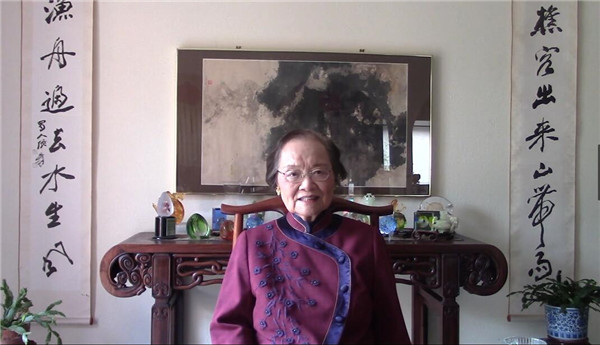
Linda Tsao Yang during video interview
Linda Tsao Yang, Chairwoman Emeritus of the Asian Corporate Governance Association, was born in Shanghai, China, and emmigrated to the U.S in 1946. From 1993 to 1999, she was the U.S. Ambassador and Executive Director to the Board of Directors of the Asian Development Bank in Manila. Ambassador Yang was the first woman Executive Director appointed by the United States Government to the board of a multilateral financial institution. During her tenure at ADB she made significant contribution to the environmental transformation of Suzhou Creek, a major transportation waterway running through Shanghai, by raising US$300 million in loans. She was given honorary citizenship by the Shanghai People’s Congress in 2016. She was then honored with the 2018 Leadership Award for Advancing US-China Relations in 2018. As a Chinese American, she has witnessed the changes and transformation China and Shanghai have gone through over the last 40 years. Amid the 40th anniversary of China's reform and opening up, our reporter has invited Linda Tsao Yang to have a video interview and share her stories from those 40 years.
Back to hometown: Shanghai was in desperate need of opening up and development
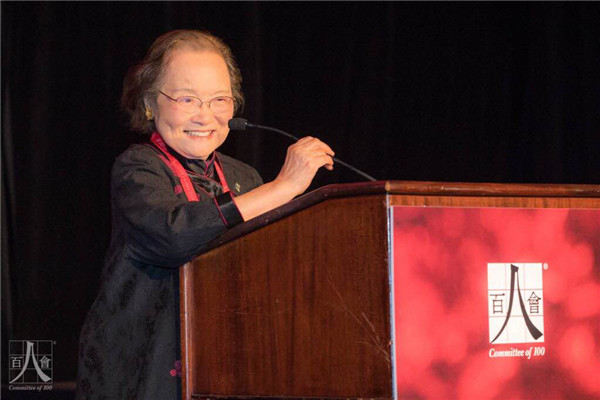
Linda Tsao Yang pictured at Committee of 100 Annual Conference 2018
"I am a genuine Shanghainese and was born in my grandmother's house near Suzhou Creek and had never left Shanghai before I turned 20," Linda recalled warmly. "I studied at the St. John's University (now East China University of Politics and Law) after graduation from a middle school for girls. I moved to New York in 1946 and studied at Columbia Business School after I graduated from St. John's University in 1945." At that time it might never have occured to Linda that she would live in the U.S from that point on.
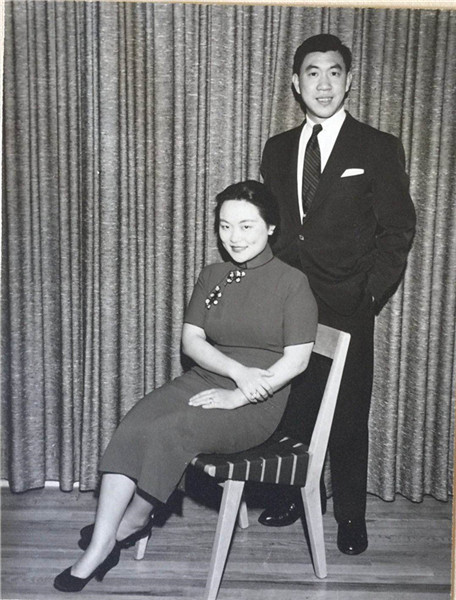
Linda and her husband Professor Yang Ci'an in the 1950s
It was in the 1980s that Linda came back to Shanghai for the first time from the U.S., when she was nearly 60 years old. "I felt the number of citizens had grown a lot. However, the colors of clothing worn by citizens on the streets were dull and drab—either grey or blue. I barely saw any new buildings and houses were old and shabby. When I strolled along West Nanjing Road, I noticed a scarcity of commodities in the store windows, which seemed not very appealing."
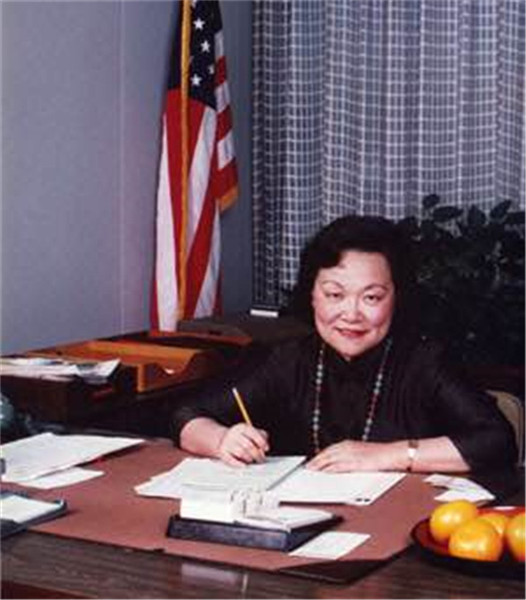
Linda Tsao served as a California Savings and Loan Commissioner in the early 1980s
Dull and stagnant. That might be Linda’s impressions about her hometown after she came back in the 1980s. However, the situation made sense to Linda at that time thanks to her background in economics and the banking industry. First, China was still an agriculture-focused economy in the 1980s and most of its population were still living in rural areas. It made sense that reform and opening up started in rural areas and cities were not given priority. Secondly, most of Shanghai’s tax revenues went to the central government and it was difficult for Shanghai to develop its infrastructure based on its own resources.
At the same time, compared with the sweeping reform and opening up in cities like Shenzhen and Zhuhai in Guangdong, the development in Shanghai was quite slow. The city was faced with such challenges as out-moded industrial equipment, an unbalanced economic structure (the proportion of the tertiary sector had dropped to less than 20%), and limited and narrow urban spaces for development. Shanghai was in desperate need of opening up and development to revitalize its economy at that time.
ADB assistance helped build the first bridges over the Huangpu River
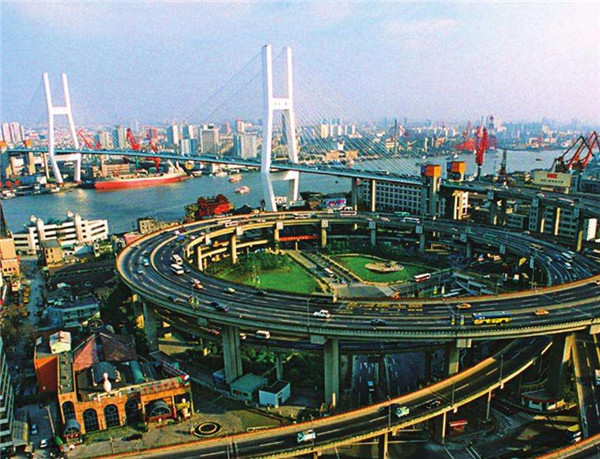
The Nanpu Bridge in 1990s
"I worked for ADB in Manila and had more opportunities to come back to China, and I think Shanghai really entered a new era in the 1990s," said Linda with excitement. "Large-scale development began in Pudong in the early 1990s and the government encouraged enterprises to set up their headquarters there. Meanwhile, the construction of the Nanpu Bridge and the Yangpu Bridge were finished and the metro system began to be expanded in the 1990s."
The construction of the Nanpu and Yangpu Bridges were closed related to the Asian Development Bank, an organization that Linda worked for from 1993 to 1999. Before the 1990s, there were no bridges and tunnels across the Huangpu river, and residents had to be ferried across the Huangpu River, the east of which was not easily accessible to most of the city, making it difficult to expand the city's narrow urban space to Pudong. However, building a bridge across the river was never an easy task, which required a large amount of money and put a high demand on design and construction capability as no bridge piers could be built under the bridge.
"The Asian Development Bank offered great support to the Shanghai government for the building of the Nanpu Bridge and the Yangpu Bridge."said Linda. According to the statistics, the Nanpu Bridge was financed by ADB loans totaling US$70 million and a joint business loan of US$48 million. This was the first joint financing project of the ADB in China. The construction of Nanpu Bridge took three years to complete and more than 7,000 workers and technicians were involved, and 41 new materials were used. The Yangpu bridge, with a record-breaking center span of 602 meters at that time, was financed by ADB loans totaling US$85 million and a joint business loan of US$79 million. The two bridges were inaugurated in 1991 and 1993 respectively, which laid a solid foundation for the development of Pudong and the boom of the service sector in Shanghai in the 1990s.
Linda's devotion to the Suzhou Creek Rehabilitation Project
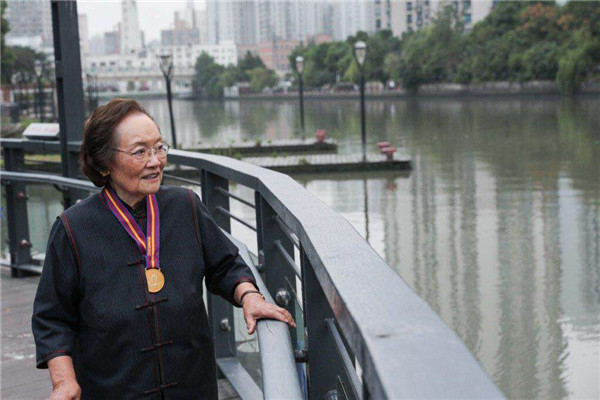
Linda Tsao pictured beside the Suzhou Creek in October,2016
Suzhou Creek has a long history and is a major transportation waterway in Shanghai. Unfortunately, the whole length of the river had been severely polluted due to the urban development and growing population by the 1990s and posed a health hazard to the people living on its banks. However, the efforts and measures to clean up Suzhou Creek were never a success until 1997.
In that year Shanghai launched a comprehensive environment treatment program to rehabilitate Suzhou Creek, with a total investment of 20 billion RMB. Linda made a huge contribution to the success of this project. She secured US$300 million in loans to ensure the successful start and implementation of the project by convincing the ambassadors of Asian countries at the ADB and officials from Washington to approve this program.
The first phase of the project turned out to be a huge success. It has reduced many serious risks to public health and has benefitted more than 3 million people living near the creek. Embankments were also built to provide green space along the creek, thus beautifying the area as well as cleansing it. Linda also followed up on the cleanup work in person during that period.
The desire for change, no matter the building of the Nanpu and Yangpu bridges for the development of Pudong or the efforts to clean up Suzhou Creek, has shown Shanghai's determination to modernise and has helped the city overcome economic stagnation and face-down numerous challenges over the last 40 years.

Linda Tsao's wishes for China's further reform and opening up
"This year marks the 40th anniversary of China's reform and opening up. The next 40 years of reform and opening up will be undertaken by the younger generation today. I want to say to them to never forget that the achievements of today's Shanghai were made by your parents and grand-parents through their hard work against all odds. I hope you make greater contributions to China’s reform and opening up with a spirit of service to communities and the society," Linda said expectantly.
.
